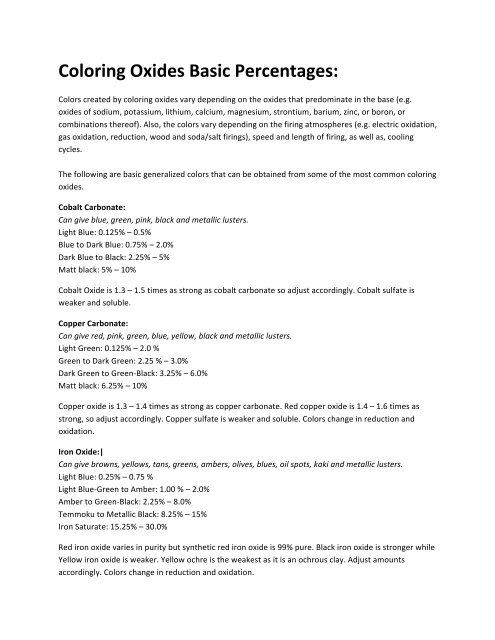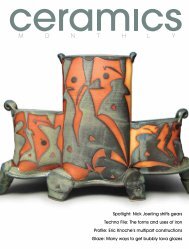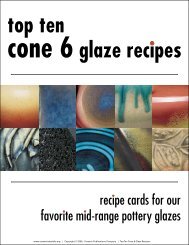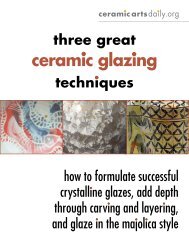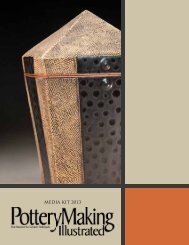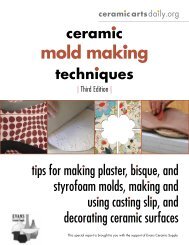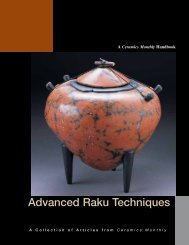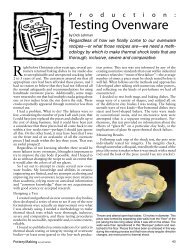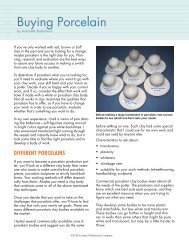Coloring Oxides Basic Percentages: - Ceramic Arts Daily
Coloring Oxides Basic Percentages: - Ceramic Arts Daily
Coloring Oxides Basic Percentages: - Ceramic Arts Daily
You also want an ePaper? Increase the reach of your titles
YUMPU automatically turns print PDFs into web optimized ePapers that Google loves.
<strong>Coloring</strong> <strong>Oxides</strong> <strong>Basic</strong> <strong>Percentages</strong>:<br />
Colors created by coloring oxides vary depending on the oxides that predominate in the base (e.g.<br />
oxides of sodium, potassium, lithium, calcium, magnesium, strontium, barium, zinc, or boron, or<br />
combinations thereof). Also, the colors vary depending on the firing atmospheres (e.g. electric oxidation,<br />
gas oxidation, reduction, wood and soda/salt firings), speed and length of firing, as well as, cooling<br />
cycles.<br />
The following are basic generalized colors that can be obtained from some of the most common coloring<br />
oxides.<br />
Cobalt Carbonate:<br />
Can give blue, green, pink, black and metallic lusters.<br />
Light Blue: 0.125% – 0.5%<br />
Blue to Dark Blue: 0.75% – 2.0%<br />
Dark Blue to Black: 2.25% – 5%<br />
Matt black: 5% – 10%<br />
Cobalt Oxide is 1.3 – 1.5 times as strong as cobalt carbonate so adjust accordingly. Cobalt sulfate is<br />
weaker and soluble.<br />
Copper Carbonate:<br />
Can give red, pink, green, blue, yellow, black and metallic lusters.<br />
Light Green: 0.125% – 2.0 %<br />
Green to Dark Green: 2.25 % – 3.0%<br />
Dark Green to Green-‐Black: 3.25% – 6.0%<br />
Matt black: 6.25% – 10%<br />
Copper oxide is 1.3 – 1.4 times as strong as copper carbonate. Red copper oxide is 1.4 – 1.6 times as<br />
strong, so adjust accordingly. Copper sulfate is weaker and soluble. Colors change in reduction and<br />
oxidation.<br />
Iron Oxide:|<br />
Can give browns, yellows, tans, greens, ambers, olives, blues, oil spots, kaki and metallic lusters.<br />
Light Blue: 0.25% – 0.75 %<br />
Light Blue-‐Green to Amber: 1.00 % – 2.0%<br />
Amber to Green-‐Black: 2.25% – 8.0%<br />
Temmoku to Metallic Black: 8.25% – 15%<br />
Iron Saturate: 15.25% – 30.0%<br />
Red iron oxide varies in purity but synthetic red iron oxide is 99% pure. Black iron oxide is stronger while<br />
Yellow iron oxide is weaker. Yellow ochre is the weakest as it is an ochrous clay. Adjust amounts<br />
accordingly. Colors change in reduction and oxidation.
Manganese Dioxide:<br />
Can give browns, purples, blacks, and metallic lusters.<br />
Light Purple: 0.125% – 2.0 %<br />
Medium Purple to Dark Purple: 2.25 % – 4.0%<br />
Dark Purple to Brown-‐Black: 4.25% – 6.0%<br />
Brown-‐Black to Matt black: 6.25% – 10%<br />
Nickel Oxide:<br />
Can give browns, greys, blues, yellows and pinks.<br />
Light Yellow to Green: 0.125% – 2.0 %<br />
Yellow-‐Green to Brown-‐Green: 2.25 % – 3.0%<br />
Brown: 3.25% – 6.0%<br />
Colors change in reduction and oxidation.<br />
Chrome Oxide:<br />
Can give greens, pink, brown, black and yellow/greens/chartreuse.<br />
Light Green: -‐0.125% – 0.50 %<br />
Green to Dark Green: 0.50% – 2.0%<br />
Dark Green to Green-‐Black: 2.25% – 6.0%<br />
Black: 6.25% – 10%<br />
Rutile:<br />
Can give, yellow, tan, and milky streaky blues and pinks.<br />
Light Yellow to Tan: 0.125% – 1.0 %<br />
Tan: 1.25 % – 3.0%<br />
Tan – streaky Rutile blue: 3.25% – 5.0%<br />
Rutile blue: 5.25% – 8.0%<br />
Colors change in reduction and oxidation.<br />
Stains:<br />
Can give most colors.<br />
1.0 – 8.0% in most glazes but can go as high as 25%.<br />
Colors change in reduction and oxidation.


